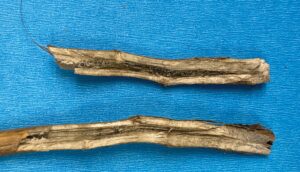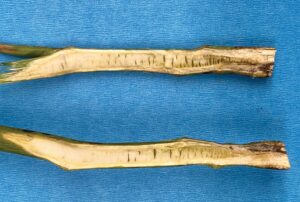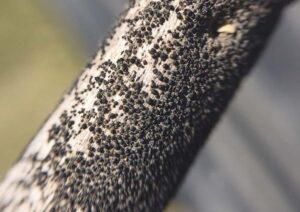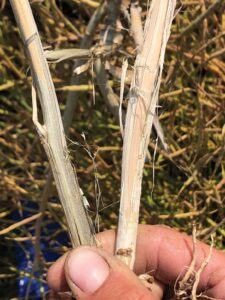How to identify verticillium stripe
You see a yield-reducing level of stem disease in your canola this fall. What is it? Blackleg, sclerotinia stem rot and verticillium stripe are the big three possibilities, and they share similar symptoms. Distinguishing among symptoms to make a correct diagnosis is an important step in future management decisions.
The following describes the symptoms of verticillium stripe and how to distinguish verticillium stripe from blackleg and sclerotinia stem rot.
Stem striping
Verticillium stripe: When the crop is full height but still green, canola plants infected with verticillium stripe will often have a two-toned stem – half healthy and green and half discoloured and drying down. This is where the “stripe” name comes from. Leaves can show similar symptoms – healthy on one side, diseased on the other.
Blackleg and sclerotinia stem rot: You will not see stem or leaf striping with blackleg or sclerotinia stem rot. Sclerotinia will cause stem discolouration, but it will not stripe half the stem.


Stem cross section discolouration
Verticillium stripe: Verticillium infects roots and enters the plant’s vascular system. Verticillium hyphae and conidia fill up the vascular system, giving the stem cross section a greyish colour. This darkening can extend well up the stem.
Blackleg: Blackleg also causes stem cross section discolouration. With blackleg, stem tissue infection tends to be darker and cause distinct wedge shapes of black. Verticillium is lighter grey and more general throughout the cross section. Blackleg discolouration is also confined to the crown area at the base of the stem.

Black specks
Verticillium stripe: As verticillium infection advances, microsclerotia will start to form on the underside of peeling stem skin. These can be found all the way up the stem.
Blackleg: Verticillium specks may seem similar to blackleg pycnidia, but they’re much smaller – more like powdery pepper. In some cases, blackleg pycnidia will have a purple-pinkish ooze of pycnidiospores around them. Blackleg pycnidia are also confined to a lesion no more than a couple centimetres in size. If you see pink and specks confined to a lesion, it’s blackleg.




Stem peeling and weakening
Verticillium stripe: Peeling stem skin is a symptom of verticillium stripe. Under that peeled outer layer will be the microsclerotia, often taking the shape of faint black vertical striping. Severely diseased stems may break off and can be confused with lodging.
Sclerotinia stem rot: Sclerotinia infection will also cause weakened brittle stems, but sclerotinia will not have the stripy, speckly microsclerotia. Sclerotinia stem rot will cause the entire stem tissue to shred, not just the outer layer. Inside the stem, sclerotinia will form sclerotia bodies – the canola-seed-sized resting bodies. Verticillium stripe does not produce sclerotia bodies.
Lab tests
For a final confirmation, PSI Labs, Discovery Seed Labs and 20/20 Seed Labs will test plant tissue for the verticillium pathogens. Members of SaskCanola and Manitoba Canola Growers can qualify for free disease testing. Saskatchewan growers, go to saskcanola.com/disease-testing-programs for instructions, including sampling protocols. Manitoba growers, go to canolagrowers.com/in-the-lab/psi-lab/ to get sampling instructions and a code for free tests.
Management
The ideal time to scout for verticillium stripe is at harvest when symptoms are most obvious. No fungicide or soil amendment is known to be effective on verticillium stripe, so accurate identification is all about future management.
Verticillium microsclerotia are soil-borne, so steps to keep soil in place could provide some reduction in spread. Two- or three-year breaks between canola crops are good disease management in general, but verticillium microsclerotia can remain viable for many years. Plant tolerance or resistance is likely to provide the best solution, and plant breeders are looking into this trait.
Blackleg and sclerotinia stem rot, if those are the diseases present, are more manageable through genetic resistance, crop rotation and fungicides.
For more on verticillium stripe identification and management, read the verticillium stripe chapter at canolaencyclopedia.ca and “Verticillium stripe identification” at canolawatch.org/fundamentals.





